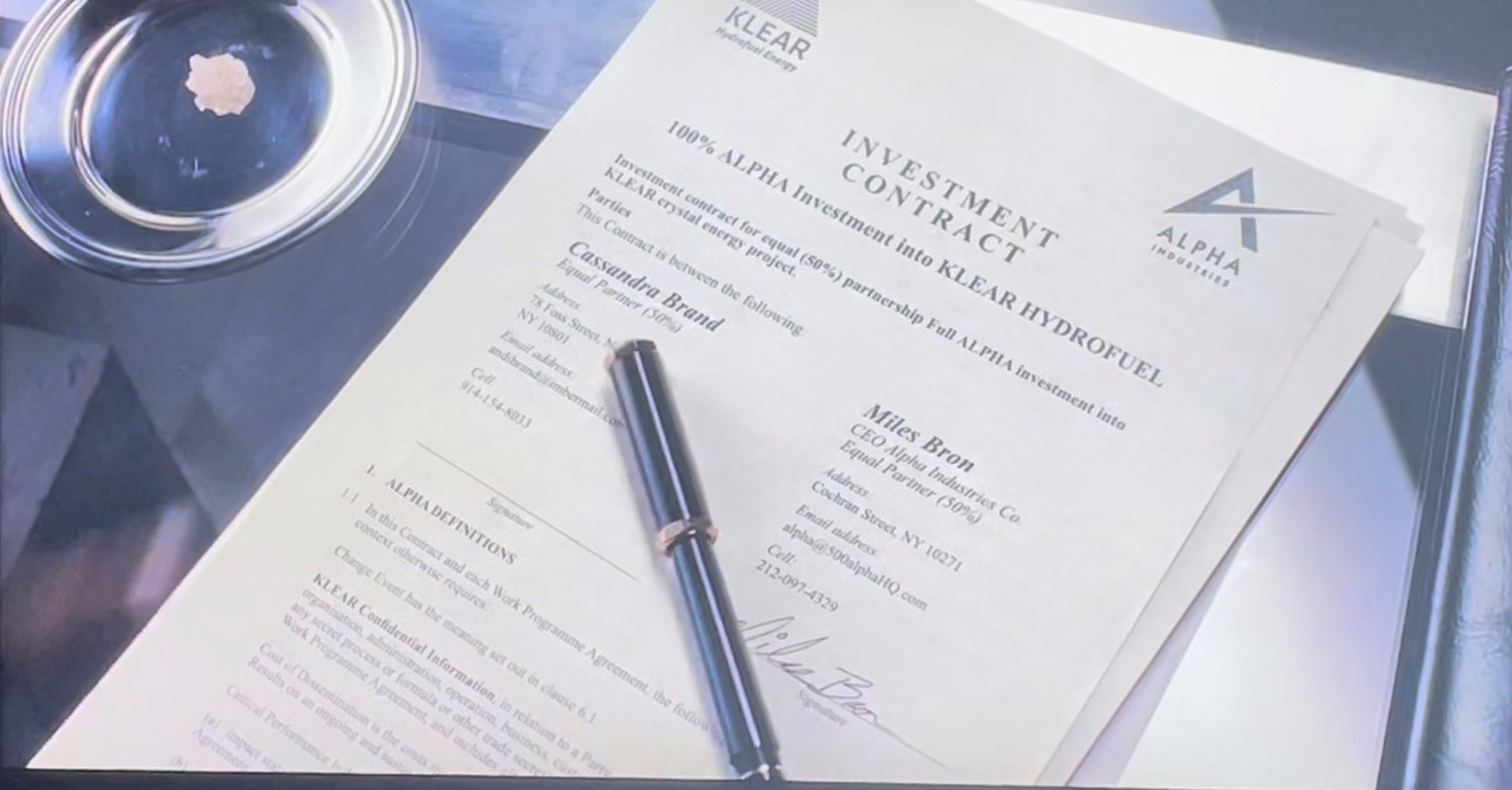Last night I watched the Netflix movie Glass Onion: A Knives Out Mystery with my daughter Sydney, who’s home for the holidays. (If you haven’t seen the movie, this reveals a piece of the puzzle, so you might want to stop reading.)
We found the movie entertaining, but given that my life’s work consists of rooting around in the contracts boneyard, the key moment was the one second during which we see the first page of a contract that establishes an important plot point. Thanks to Sydney, here’s a screenshot:
The reason for the contract is that one character, Miles Bron, was, in the words of another character, “willing to give the company’s entire resources to launch this thing,” namely a “new hydrogen fuel,” KLEAR Hydrofuel. Miles owned the company (Alpha Industries) with Cassandra Brand, hence the ostensible need for a contract.
Here are my thrilling insights:
- Why is the KLEAR Hydrofuel logo at the top? Whoever owns KLEAR isn’t party to this contract.
- WTF is the function of the subheading “100% ALPHA Investment into KLEAR HYDROFUEL”? Is it meant to serve as a sort of recital? If so, it fails, as it’s cryptic. 100% of what? Into what? This caused Sydney, who’s in private equity, to cycle through the seven stages of grief in four seconds.
- “Investment contract for equal (50%) partnership”? OK, but we already know that Bron and Brand are joint owners of Alpha, so it’s not clear what the contract is meant to memorialize. The decision to invest in KLEAR? That wouldn’t require a contract. Are they agreeing to make a capital contribution? There’s no sign of that.
- The phrase equal (50%) partnership doesn’t occur on the U.S. Security and Exchange Commission’s EDGAR system, the final resting place for millions of contracts filed by public companies. And I wasn’t able to find an instance of just equal (50%) on EDGAR, so it wouldn’t seem to be a thing. I was mildly disappointed.
- Bron and Brand are each entering into this contract in their personal capacities and not through some corporate vehicle, tax or liability concerns be damned? Sheesh.
- Bron’s address is “Cochran Street, NY 10271.” How about a street number? And there’s no Cochran Street in that zip code. Points for implausibility.
- “This Contract is between …” The capital C is, of course, deeply stoopid (see this 2016 blog post), but it’s also standard. A bizarro movieland contract isn’t the place to look for cutting-edge rationality—that’s my job!
- Beginning the body of the contract with a definition section? Again, that’s unhelpful but standard, so I can’t complain.
- But it is weird to call the definition section “Alpha Definitions.” I’ve never seen a definition section that claims to contain only defined terms relating to one party.
- It’s usual to use quotation marks when you create a defined term. This contract doesn’t do that.
- This contract uses bold for one of the defined terms featured in the definition section, but not the others. That made my left eye start twitching.
- Why does the defined term KLEAR Confidential Information occur in the contract? KLEAR isn’t party to the contract.
- This contract uses is as a definitional verb in the definition of Cost of Discrimination? Ay, caramba! See this 2021 bog post.
- Why was this contract drafted by an English lawyer? Programme. organisation.
Thus endeth this exploration of an alternate-Hollywood-reality contract. (For another example, see my 2018 blog post about the contract featured in the movie Ready Player One.) Contracts in movieland seem as messed-up as contracts in real life, but less depressing.


This is why I can’t watch dramas about lawyers. Every couple of minutes, there’s something that breaks my suspension of disbelief. One thing pulling me out is OK because I can get back into the show. And somehow, comedies that barely make a pretense at representing the law (eg Ally McBeal) are OK.
I watched Glass Onion last night too and also found the contract out of place. I suspended my disbelief to enjoy the rest of the movie.
Chris and Michael, I found the movie enough of a fantasy that this contract didn’t get in the way of my suspending disbelief.
So what did your daughter Sydney think of you stopping to review the agreement? :-)
What is an “oh dad, not again” moment?
Hi Kara. I think I had the good sense to revisit that part after we had watched the entire movie. But even if had insisted that we stop everything to get the screenshot, the long-suffering Sydney would have rolled her eye but indulged her father: she’s used to my obsessions!
Hi Ken,
thanks for the thorough work! Normally, I am quite peeved by these things (because it would take so little effort to get them right), but this time, I feel like it’s on purpose. Think about it: The contract appears in a scene that is a narrated flashback, and the narrator (Helen) wasn’t in the room and is not a business expert. This is what she imagines the contract would look like after her sister told her about it. And yes, Rian Johnson is more than capable of that level of detail. (Notice, for example, that Helens handwriting features an “A” much like the Alpha Industries logo, indicating that her sister probably designed that as well…)
Thanks, Paul. I’m not annoyed by these things, and indeed a slapdash contract might make more sense in the context. But it humors me to point stuff out!